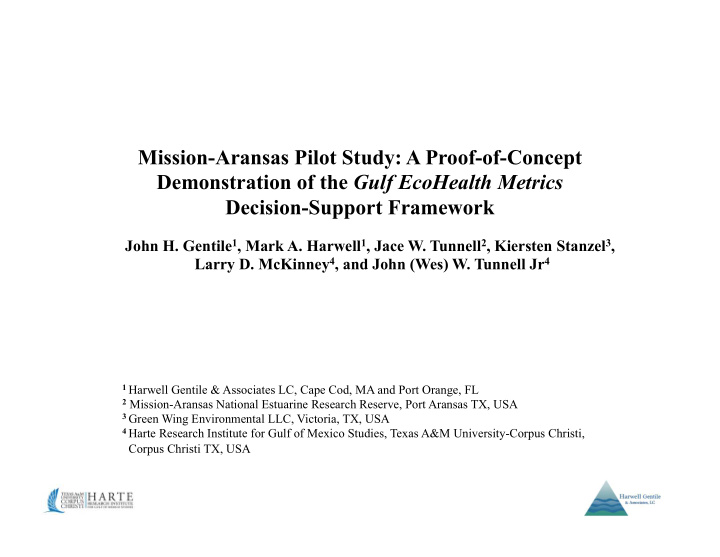



Mission-Aransas Pilot Study: A Proof-of-Concept Demonstration of the Gulf EcoHealth Metrics Decision-Support Framework John H. Gentile 1 , Mark A. Harwell 1 , Jace W. Tunnell 2 , Kiersten Stanzel 3 , Larry D. McKinney 4 , and John (Wes) W. Tunnell Jr 4 1 Harwell Gentile & Associates LC, Cape Cod, MA and Port Orange, FL 2 Mission-Aransas National Estuarine Research Reserve, Port Aransas TX, USA 3 Green Wing Environmental LLC, Victoria, TX, USA 4 Harte Research Institute for Gulf of Mexico Studies, Texas A&M University-Corpus Christi, Corpus Christi TX, USA
Mission-Aransas Reserve Pilot Study Goals : • To test the integrated assessment framework and associated indicators in a real- world environmental management application. • To specify key indicators for assessing ecological health and Linking Ecosystem Health, Services, and Well-Being ecosystem services and identify their linkages to well- Societal & Natural being. Drivers, Pressures, & Stressors Management Responses • To conduct a proof-of-concept Indicators of Indicators of Indicators of Supporting Ecosystem Health Ecosystem Services Well-Being Services • Structures • Provisioning • Connection to Nature pilot study focused on specific • Processes • Regulating • Living standards • Diversity • Cultural • Health, etc. management issues of the Mission-Aransas NERR . Environmental Decision-Making • MANERR Pilot • Proof of Concept • Decision Support
Decision Support Framework Problem Formulation • Determine Management Needs • Identify Ecological & Societal Needs • Determine Project Goals/Objectives • Develop Case-Specific Conceptual models Propose Alternatives • Acquire Baseline Information • Identify Alternative Actions Alternative Analysis • Conduct Scenario-Consequence Analysis • Conduct Feasibility Analysis • Identify Trade-Off Analysis Decision • Select Optimal Alternative • Establish Monitoring Plan • Identify Goals/Targets
Mission-Aransas Reserve Pilot Study Management Goal: To create or extend rookery islands in the coastal systems of the Reserve in order to enhance nesting, breeding, and foraging habitat for resident and migratory coastal birds, which provide ecosystem and well-being services to a range of beneficiaries. Approach: A structured decision-support framework, using geospatial ecosystem-based management tools and scenario-consequence analyses, is employed to assess the trade-offs inherent in managing the complex interactions of coupled human and natural systems.
Mission Aransas Dredged and Natural Islands Climate Change & Physical Processes Geohydrology Climate Change/Variability Sea-Level Rise Ocean Sea- Hurricanes/ Subsidence Circula*on Level Rise Storms Precipita*on Sedimenta*on Erosion Changes Wave & Colonial Whooping Areal Extent / Waterbird Erosion Waterbird Crane Distribu0on Habitat Protec0on Rookeries Habitat
Mission Aransas Dredged and Natural Islands Human Activities Recrea0on Shipping Industry Commercial Fishing Development Habitat Resource Marine Human Presence Altera*on Harves*ng Debris & Noise Wave & Colonial Whooping Areal Extent / Waterbird Erosion Waterbird Crane Distribu0on Habitat Protec0on Rookeries Habitat
Rookery Island DPSCR Framework Pressures/Stressors Condi0on AKributes Eco-Services Well-Being Physical • Hazard Mi0ga0on Structural AKributes • Health • Hydrology • Recrea0on • Areal Extent • Economic • Salinity • Naviga0on • Habitat diversity • Recrea0on • Precipita0on • Habitat Value • Structural complexity • Cultural • Erosion • Food Provisioning • Successional PaKerns • SLR/Inunda0on • Breeding Residents • Storms • Winter-Migratory • Noise Linking Ecosystem Health, Services, and Well-Being Chemical Func0onal AKributes • Nutrients • Erosion Protec0on Societal & Natural • Petroleum releases • CWB Breeding Habitat Drivers, Pressures, & Stressors • Pes0cides/Herbicides • WB Non-Breeding Habitat Management Responses • Whooping Crane Habitat Indicators of Indicators of Indicators of Supporting Biological • Fish Habitat Ecosystem Health Ecosystem Services Well-Being Services • Structures • Provisioning • Connection to Nature • Processes • Regulating • Living standards • Food Availability • Invertebrate Habitat • Diversity • Cultural • Health, etc. • Preda0on • Seagrass Habitat • HAV • Oyster Habitat Environmental Decision-Making • MANERR Pilot • Human Presence • Marsh Habitat • Proof of Concept • Decision Support
Facilitates the capturing of spatial and non-spatial information and conservation requirements for elements, defining scenarios for land use, management, conservation, disturbance, etc., and evaluates the impacts of scenarios on the element. Land-use Type Policy Type Evaluation Maps & Reports Scenario Outputs (baseline, trends, alternatives) Alternative scenario development Elements, values, & expert knowledge Evaluation Maps & Reports
Rookery Island Site NatureServe Conservation Elements Waterbird Survey Data Geospa5al Analyses Landscape Variables Waterbird Survey • Distance from land/predators Data (1970-2015) • Eleva0on Hydrologic Variables Geospa0al Analysis of • Bathymetry Waterbird Data • SLR/Surge Biologic Variables Map Loca0on of • Vegeta0on % cover & diversity Clusters/Islands • Distance from feeding habitats Analyze Species Abundance & Diversity Trends Geospa0al Analyses • NatureServe Vista planning tool Recommend Eco-based • Ranked/scaled conserva0on elements Si0ng Criteria/Bounds • Op0mize areas for candidate sites Proposed Candidate Sites Proposed Candidate Sites Final Site(s) Selec0on
Mission-Aransas Reserve Pilot Study Next Steps: • Complete mapping of “conservation elements” • Use INVEST to link VISTA geospatial indicators to ecosystem services in the scenario analysis • Conduct scenario-consequence analyses to assess feasibility & trade-offs • Demonstrate the utility of conceptual and decision support frameworks • Complete project during this fiscal year • Prepare manuscript for peer-reviewed publication on integrated assessment/decision framework and pilot study
Recommend
More recommend